Your Child Can Learn How To Sound Out Words!
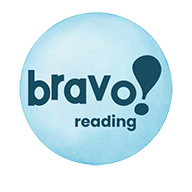
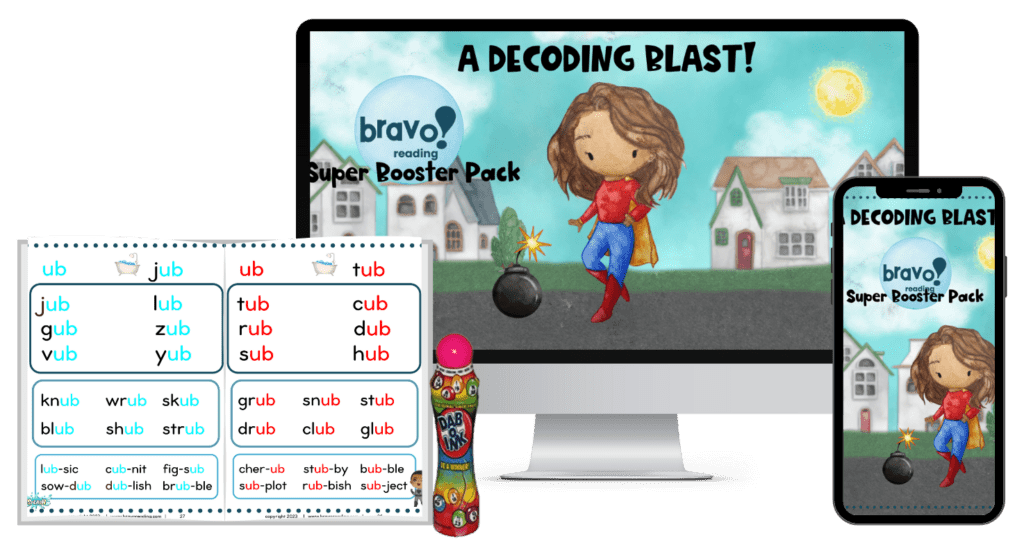
When you ask your child to sound out words, do you cringe? Have you ever been scared for your child’s future because of dyslexia or poor reading skills?
The stammering.
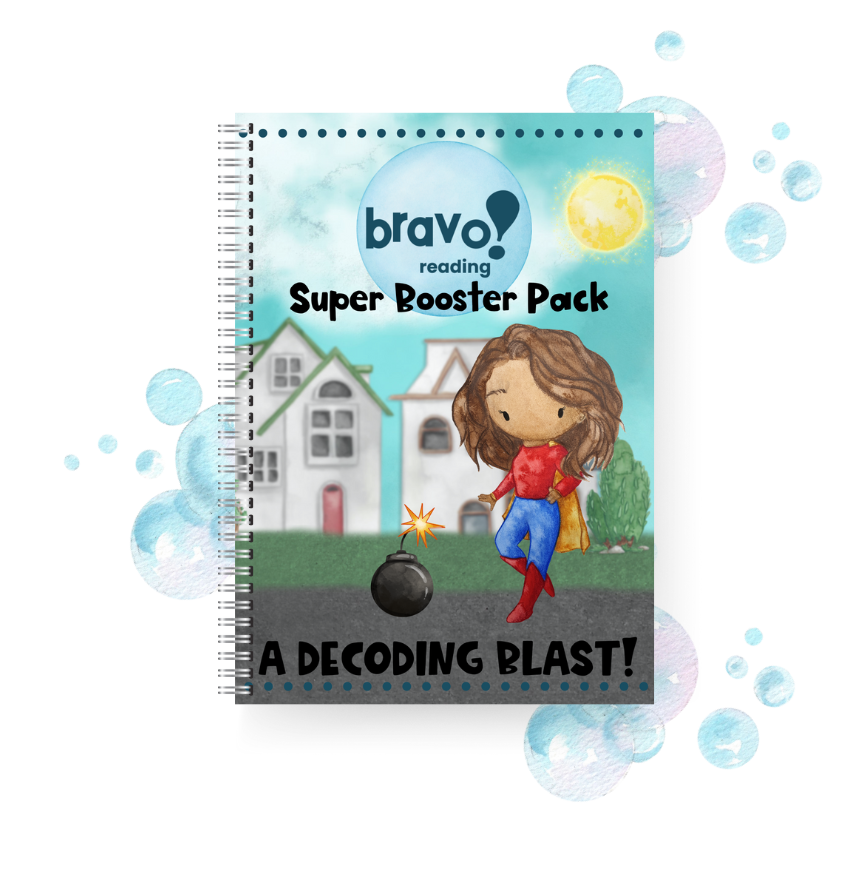
The stuttering.
The intense guessing at words.
It can keep you up at night, worrying, fretting. Wondering where it will all end!
Even worse, most kids with dyslexia are miserable. They hate school, perhaps enduring days when only sports, art, or friends are a bright spot.
Then, there are the endless nights of homework.
Most kids with dyslexia try so hard, but they fail to make the mark. Time and again.
It’s a wonder they keep swinging at all!
Your child’s teacher lets you know fluency is a problem as well. And comprehension is probably spotty. One day it’s there; the next minute it flew out the window.
Why Sounding Out Words Is Important For Kids With Dyslexia
It’s extremely important that your child knows how to sound out words! But kids with dyslexia have such a hard time with this skill.

It seems so simple. A letter has a sound. Two letters together will have a sound. Blend them together to create words.
Easier said than done if you’re dyslexic!
The bit-by-bit thinking necessary for sounding out words is foreign to kids with dyslexia. It’s like asking them to cross a busy street without a traffic signal. They don’t know when to start, when to stop.
Sometimes, they run, and sometimes they stand petrified in the middle of the street.

Sounding out words is called decoding, and it’s the backbone of reading.
So…what’s the big deal?
By definition, decoding is the process of translating printed words into speech. In simpler terms, it’s the ability to sound out words.
The reason your child’s fluency skills are poor is because it’s hard for your child to sound out words.
Kids with dyslexia are notoriously bad at decoding. This skill simply doesn’t make sense to them. Most kids with dyslexia are right-brain dominant learners. This means they are creative, and learn best through movement, color, music, and rhythm. They also learn best by seeing the “whole” of something.
Decoding is a left-brain activity. It also involves bit-by-bit learning, and this is extremely difficult for the dyslexic child, who sees the “whole”, not the “bit by bit”. It’s difficult to sound out words when you’re operating from the wrong side of the brain!
Kids with Dyslexia Need Unique Methods to Sound Out Words!
If you’ve ever purchased materials for your child like flashcards or phonics workbooks and found they didn’t work, it’s because they are geared toward the left-brain dominant learner.

Using these materials is like speaking a foreign language to your child!
And they certainly won’t help your child sound out words.
But your child can learn to decode and sound out words if the right “learning language” is used.
This means your child needs large motor movement, a multi-sensory approach, color, pictures, predictability, and brain-based learning to best learn to sound out words.
These Kids Are Smart, But They Need Something Better!
Kids with dyslexia learn differently than other kids. That doesn’t mean they aren’t smart. One of the symptoms of dyslexia is average or above average intelligence.

What it does mean is that a child with dyslexia needs a different way to learn. Traditional methods don’t work with these kids.
They need a system that makes sense to them, not a program that was developed for mainstream students in America. No wonder it’s so hard for kids with dyslexia to sound out words!
Did you know that if your child has had one solid year of instruction and still struggles to read and reverses letters and numbers, that it’s a strong indicator of dyslexia? And here’s the sad truth. Kids don’t outgrow dyslexia or have an overnight epiphany where skills suddenly fall into place without proper interventions.
When You Learn Differently Than Others…
The downfall of not getting the right often help plagues these kids for life. Proof of this is that 48% of our prison population is dyslexic.

But early interventions make a huge difference to kids with dyslexia! Not just any intervention will work, though. It must be an intervention that speaks in the dyslexic child’s “learning language”.
Kids with dyslexia usually have weak visual and auditory processing systems.
This means it’s difficult for them to process information in a visual or auditory manner. Kids with dyslexia are also usually tactile or hands-on learners.
This means they learn by doing, not by seeing or hearing. They need a way to sound out words that uses large motor movements.
Why Movement Is Their Jam!
Kids with dyslexia rely on movement to learn, especially when they try to sound out words. Movement is their jam!

Yet, traditional reading and decoding programs fail the dyslexic learner from the start. Like phonics sheets and flashcards aren’t bad enough for them, they struggle with a lack of large motor movement in most traditional materials.
Remember…movement is how they learn best. Circling a phonics picture with its matching sound simply isn’t enough movement for a child with dyslexia! They need targeted movements to sound out words. When they use these movements, it “clicks” and decoding words becomes easy.
Traditional methods don’t resonate with kids who have dyslexia. They simply won’t work because the wrong “learning language” is being spoken!
Turn It Around: How To Get Rid Of Bad Reading Habits
Kids with dyslexia struggle to sound out words. This means that when they come to a new or unfamiliar word, they lack strategies to sound it out or decode it.
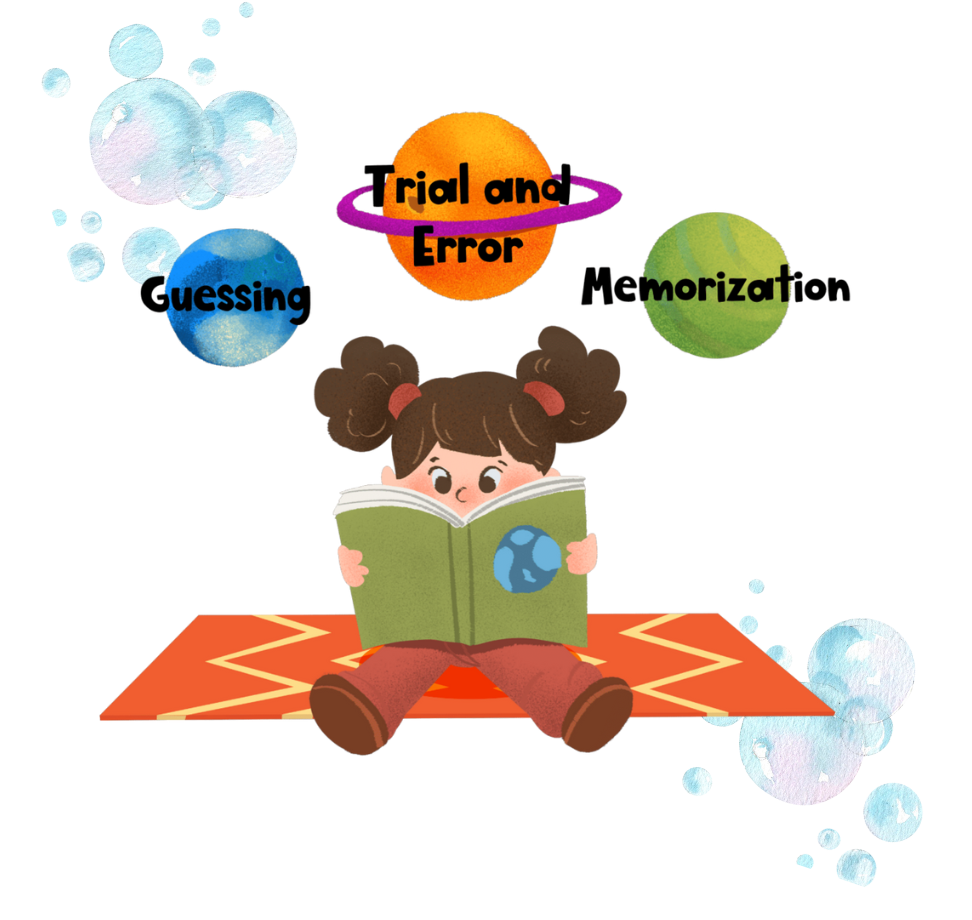
There are three main bad habits a child with dyslexia engages in while trying to sound out words, and they all do damage in different ways. We call these the Three Pillars of Poor Reading.
The first Pillar of Poor Reading is guessing at words. This is the most common bad habit that kids with dyslexia engage in, and it is one of the worst bad habits a child can engage in when attempting to sound out words. Here’s how it works:
When your child is decoding and comes across a new or unfamiliar word, a sense of panic sets in because decoding strategies are weak. Your child has no choice but to take a wild guess at the word.
It gets worse with multi-syllable words. Often, your child does well with the first syllable of the word. But second and third syllables usually cause problems. There are so many letters, all bunching up together. Your child’s perceptual skills are probably weak, and auditory sounds are jumbling.
When Sounding Out Words Causes Panic
Big panic sets in under this circumstance and a wild guess is made. Sometimes, the guess is correct, but most of the time, your child guesses wrong.

Guessing at words is just a bad habit. It doesn’t get fixed by correcting your child because your child is still missing strategies to sound out words when new or unfamiliar words pop up! Correcting needs to take place while learning to decode words…not when the child is expected to have reading fluency and read words out loud with automaticity.
Automaticity is the ability to do something without using consciously thinking about it. It’s automatic. Reading relies heavily on automaticity. Other skills that require automaticity are driving, riding a bike, and typing.
Kids with Dyslexia Often Form Bad Reading Habits
The second Pillar of Poor Reading is memorizing words. Because your child lacks decoding strategies, it’s tempting to try to memorize words.

At first, this sounds like a fantastic idea! But when you discover our language has over a million words in it, then it’s obvious what a big task memorizing all those words could be! Even worse, with memorization, your child makes no attempt to sound out words, so decoding strategies are missing.
Adding fuel to the fire…kids with dyslexia are usually weak in visual and auditory skills. To ask them to memorize over a million words is like asking them to climb Mount Everest!
The final Pillar of Poor Reading is using trial and error reading. Trial and error reading is when your child randomly applies reading and spelling rules to words instead of sounding them out.
At least there’s a bit of strategy involved in this bad habit. The problem arises when your child gets the answer correct, which at first doesn’t make sense. But in a way, it’s a false positive. Your child isn’t sure how the word was decoded because your child had no idea how the rule was learned in the first place.
Random Attempts to Sound Out Words Aren’t Strategies
When your child misreads a word while using trial and error reading, there’s no process of elimination involved.

Your child can chalk it up to something that didn’t work or any other random thing, because your child isn’t sure what worked in the first place.
There are way too many variables with trial and error reading. When kids engage in this bad habit, they don’t even attempt to sound out words. That’s because they’ve failed at sounding out words too many times. It’s easier for them to use bad habits than learn to decode words.
All three Pillars of Poor Reading are simply bad habits and can be corrected – often in as little as three weeks, providing the right techniques are used
Research lets us know that phonemic awareness is vitally important to help kids with dyslexia sound out words.
Phonemic Awareness Helps Your Child Sound Out Words
Phonemic awareness is the ability to recognize and manipulate the spoken parts of words, including initial letters, syllables, and phonemes.
Phonemes are the smallest units of speech that distinguish one word from another. There are forty-four phonemes in our language.
Examples of phonemes are “ap”, “ib”, “ex”, “ot”, and “up”. By adding a letter to these phonemes, you will get a three-letter word. For instance, if you add the letter “c” to the phoneme “ap”, you end up with the word “cap”.
From there, you can keep building on these phonemes until you arrive at multi-syllable words.
With the Right Set of Tools, Sounding Out Words is Easy!
Children with dyslexia are usually weak in phonemic awareness. They don’t understand how this building block process works, so they end up using bad habits to try to sound out words. But with the right set of tools, kids with dyslexia can learn to use phonemes like the back of their hands!
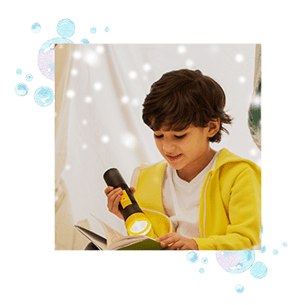
Through large motor movements, your child can learn to use phonemes correctly in reading. With color, pictures, and a multi-sensory approach to learning, then your child can become a master at phonemes. Add in brain-based learning, and it all suddenly clicks. This is when your child starts to sound out words easily. It’s when reading skills start falling into place!
A multi-sensory approach to learning is one that uses visual, auditory, and kinetic means to teach the skill. Since kids with dyslexia are usually weak in visual and auditory skills, this is a necessity for them. The tactile part of the process carries them.
But not all tactile methods work.
Your child needs larger motor movements to sound out words. Add in color, pictures, and brain-based learning where new neural pathways are built in the brain, and phonemes are now strong for your child!
The Bravo! Super Booster Pack Helps Your Child Sound Out Words!
The Bravo! Super Booster Pack strengthens your child’s phonemic awareness so your child can sound out words quickly and easily. This equates to stronger decoding skills, better reading fluency, and higher comprehension scores.
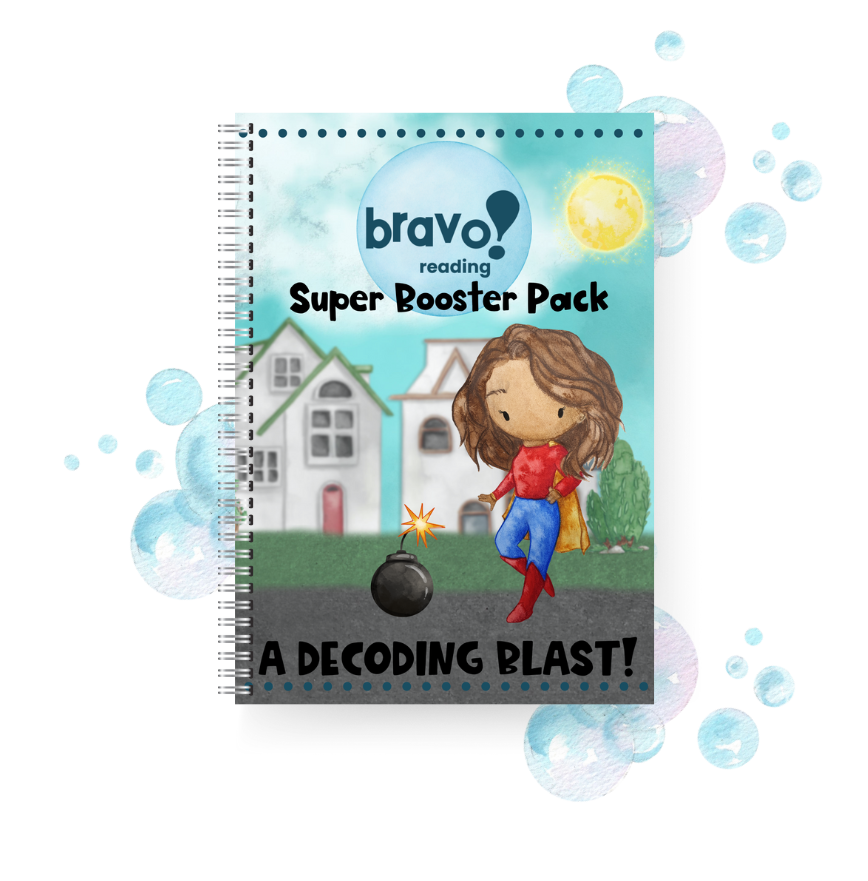
Based on tried-and-true Orton-Gillingham research, the Super Booster Pack uses movement, color, picture cues, visual cues, a multi-sensory approach, brain-based learning, and predictability to help your child reach phonemic awareness and decoding mastery! With these methods, your child will sound out words like a reading shark!
The Bravo! Super Booster Pack is second in line of Bravo! Reading’s expansion packs. It is meant to be used after the Bravo! Booster Pack and before the Bravo! Decoder Pack. It has over one hundred and sixty pages of phonemic awareness and decoding practice, all aimed at showing the dyslexic child how to sound out words.
To use the Bravo! Super Booster Pack, your child must know all letter sounds and have the ability to blend three letters together to form a word. It is designed for older students, grades three and above, but if your child can use the Super Booster Pack if reading at the second-grade level.

Use the Bravo! Super Booster Pack to Sound Out Words!
Using the Super Booster Pack is easy. It is divided into four separate levels. Level 1 focuses on digraphs and blends, adding them to small phonemic units of sound with the Bravo! Reading movement/chunking process.

By using this chunking process along with the Bravo! techniques, your child is soon able to sound out words, even tricky multi-syllable words!
Digraphs and blends are two consonants that come together to form one new and unique sound.
Understanding this concept can be confusing for kids with dyslexia, so we start right out having them add consonant blends and digraphs onto basic phonemic units to build a strong decoding foundation.
Explore Larger Units Of Sound And Make The Grade!
Level 2 allows your child the opportunity to explore larger phonemic units. This is where true phonemic awareness sets in. The process of chunking is the same as in the first level. This is the stepping stone to reading multi-sensory words.

The third level of the Bravo! Super Booster Pack is a really important section for kids with dyslexia. It focuses on variants, which are those words that don’t follow traditional spelling and reading rules. These are those “exception to rules” words that don’t make sense to the dyslexic child.
Most traditional reading programs simply put these words in text, not giving any route to memory, especially not movement. It’s as if they are just hoping the child will automatically learn them. The majority of kids can do this, but that won’t work for the dyslexic child.
Through movement, color, pictures, and chunking, your child learns about variants in a way that makes sense.
Step-by-step, your child learns to sound out words like a champ.
The Most Powerful Use Of Chunking Available
The final level of the Bravo! Super Booster Pack teaches your child how to use vowel blends in words. Once again, this is a super tricky skill for kids with dyslexia.

They have a difficult time understanding that two letters can come together to form one new and unique sound. But once vowel blends are mastered, your child’s ability to sound out words soars!
This is a difficult skill for them when consonants are used, but when vowels are used, it really trips up kids with dyslexia. Vowels in general are perplexing for kids with dyslexia. Since these kids usually have compromised auditory processing systems, they don’t hear the subtle differences between vowel sounds.
The Bravo! Super Booster Pack has the most powerful use of chunking, graduating print, and multi-sensory based techniques in any decoding program. This is the secret ingredient that makes sounding out words easy.
The Super Booster Way to Sound Out Words
At the top of each page of the Bravo! Super Booster Pack is a small phonemic unit that the entire page focuses upon.

There is also a picture that goes with the phonemic unit. For instance, if the phonemic unit is “op” and the first word is “chop”, there is a picture of an ax – since it goes with the word “chop”.
Your child uses a fat marker to slide across the decoding unit, the picture, and then the phonemic unit at the top of the page. At the same time, your child says the sound of the decoding unit, picture, or phonemic unit makes. This sliding process helps your child sound out words.
This is brain-based learning at its best, as new neural pathways are being built in the brain while this happens! Your child is also engaging in larger motor movement while sliding the marker across the large pictures and print.
From there, your child moves down the page to the “meat” of the Super Booster Pack.
Movement As The Magic Elixir for Kids with Dyslexia!
The process continues with your child sliding the fat marker across extremely large print while saying the sound of the decoding unit or phonemic unit aloud at the same time.

Words are split into two distinct pieces by bright colors.
This brings your child’s attention to the letters that are usually glossed over while trying to decode.
From there, the process continues, only the Bravo! Super Booster Pack does something unique, something traditional reading and decoding programs neglect.
How Three Boxes Help You Sound Out Words
The print in the Bravo! Super Booster Pack gets gradually smaller. This gives your child a chance to succeed right off the bat!

There are three boxes of different print size on every page, and this helps kids with dyslexia gain decoding confidence.
As your child moves down the page, using large motor movements, the print gets smaller. The final box on every page is much smaller so your child can transition easier to real world reading.
Once your child can read all levels of print and all columns in the Super Booster Pack, the ability to sound out words sticks. Decoding is easy. Fluency is no longer a chore, and stuttering at new words disappears!
Stop The Insanity: Using New Methods to Sound Out Words
Traditional reading programs use extremely small print by the time a student reaches the fourth grade. This small print is especially aggravating to kids with dyslexia or other visual processing disorders. That’s because it’s too small for them to distinguish minor differences between letters and words. Obviously, this slows them down, and that directly affects their ability to read fluently.
There’s no need for this, especially during the process of learning to decode! Immediate success should be the goal, not an archaic system that doesn’t meet the needs of dyslexic learners.
Bravo! Reading knows that graduating print size is helpful for helping kids with dyslexia sound out words. It offers them huge print at first to gain confidence then slowly “weans” them into smaller versions! This gives them the immediate success they need as well as prepares them to sound out words with confidence in the real world.
A Sample Page from the Bravo! Super Booster Pac
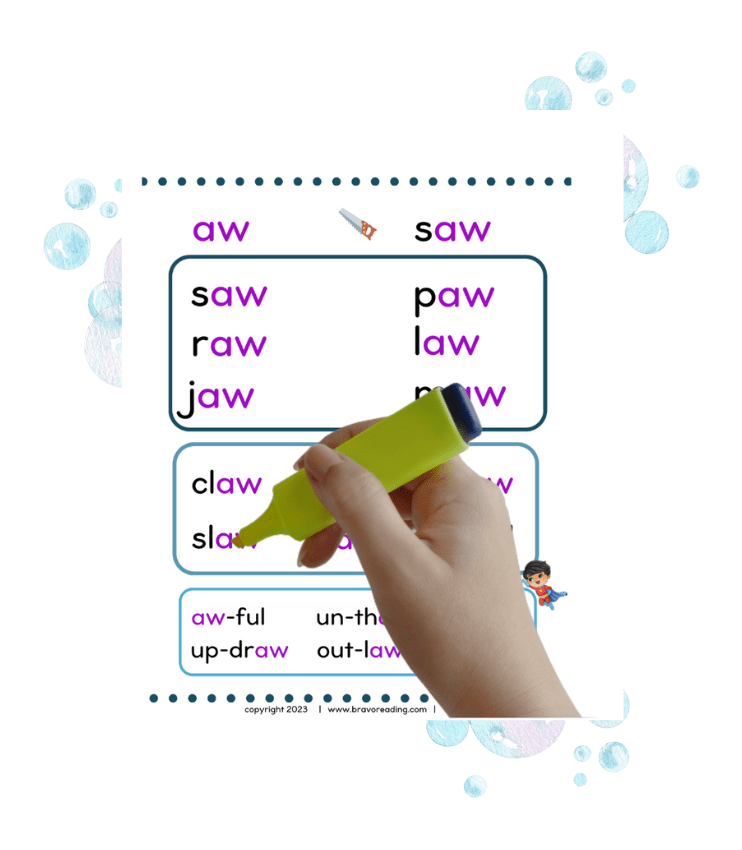
How Nonsense Words Help You Sound Out Words
The use of nonsense words helps to break the bad habits that dyslexic readers often engage in. Because these readers usually lack or are weak in decoding strategies, they end up using the Three Pillars of Poor Reading, which are just bad habits.

Did you know it takes three weeks to stop a bad habit? That means that in as little as three weeks of using the Bravo! Reading Super Booster Pack that your dyslexic reader can stop using these poor decoding habits!
That’s amazing!
Add in nonsense words, and suddenly, the ability to sound out words isn’t such a chore.
By using nonsense words, your child doesn’t guess at words and decodes them instead. This is because kids with dyslexia are quite attached to meaning. It’s what holds them together in an all too often “topsy-turvey” world.
Kids with dyslexia don’t perceive the world like other kids. Their worlds might be moving, slanted, upside down, or backward. We can’t be entirely sure how they perceive information, because we can’t crawl inside their brains. And they can’t always tell us about it, because they were born this way and it’s all they know.
Science has figured out quite a bit, though. And Bravo! Reading uses this research to help your child sound out words.
Seeing Images In Different Ways: A Major Cause Of Confusion
Did you know that kids with dyslexia can perceive an image in as many as forty different ways? And that it might be one way one day and a different way the next…

You might cling to meaning if this were the case, too.
When a child with dyslexia starts to sound out a word, the meaning of the word is too tantalizing. And…it’s too difficult to sound out the word because too many bad habits have set in and because decoding isn’t a natural process for these kids
Kids with dyslexia strike out for meaning when trying to sound out words, and this is often why they end up guessing at words. They want that immediate satisfaction of meaning.
With nonsense words, your child can’t go for meaning over decoding, because there is no meaning attached to a nonsense word! Decoding has to happen with nonsense words, because there’s no other choice!
And because your child is practicing sounding out words with gross motor movements, color, pictures, a multi-sensory manner, brain-based learning, and predictability, decoding skills set in like magic!
A Sample Page from the Bravo! Super Booster Pack
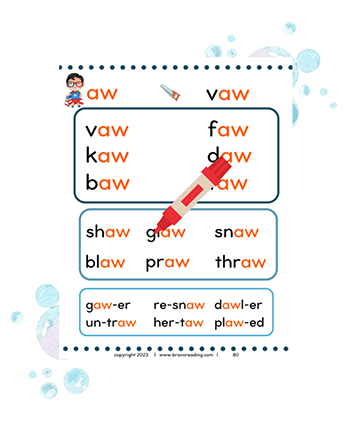
The Bravo! Super Booster Pack uses phonemic units to help build a reading foundation for your dyslexic reader. Phonemic units are those small units of sound that our language is made of, and when your child has a strong grip of these units, it’s easy to sound out words!

Once your reader has a firm grasp on these small units of sound, we add bits and pieces to them, one step at a time! This helps your child learn to sound out words without getting overwhelmed, without asking too much in the beginning stages.
There are three boxes on each page of the Super Booster Pack. Readers work on one box at a time until decoding confidence is achieved. By the third box, readers are sounding out two-syllable words with confidence!
This works so much better than randomly throwing in large, multi-syllable words in reading text, which is what traditional reading programs do. Dyslexic children need to learn in stages, to step-by-step build a decoding foundation.
Don’t Panic When It’s Time To Sound Out Words!
When they are faced with a long, multi-syllable word without proper tactics, strategies, and cues to use, kids with dyslexia panic! This doesn’t help the child sound out words.

When your dyslexic reader completes the Bravo! Super Booster Pack, two-syllable words are read with ease.
This translates to reading fluency and comprehension confidence. It also carries over into other subjects, and that’s when test scores and grades increase.
Panicking never helps a situation. When your child gains the decoding security provided by the Bravo! Super Booster Pack, grades increase and homework battles end.
That’s because reading carries over into every subject in school.
Your relationship with your child can go back to normal. Joy and pride take the front seat instead of embarrassment and frustration!
- You’ll receive the Bravo! Super Booster Pack as a digital file so you can get going right away! Although you can use the Super Booster Pack on a tablet or computer, we highly recommend printing it off and using a fat-tipped marker to guarantee gross motor movement while learning to decode words.
- In order to use the Bravo! Super Booster Pack, your child must know all letter sounds with automaticity. If your reader is struggling to learn letter sounds, the Bravo! Beginner gets the job done in short order.
- Your child also needs to know how to blend three letters together with automaticity. This means your child needs to do this without using conscious thought. If your child can’t yet do this, we recommend the Bravo! Punch Pack and the Bravo! Snap Pack. They are both free resources. If your child still is struggling to blend three letters together, we recommend the more complete and thorough Bravo! Reading Program. (You can get all these programs and more in the Complete Bravo! Reading Program!)


Get the Super Booster Pack In The Bravo! Bundle For More Value!

Save money and get more with The Bravo! Bundle. When you order The Bravo! Bundle, you’ll receive the entire eleven levels of the Bravo! Reading Program, the Bravo! Beginner, and all Bravo! Expansion Packs – including the Bravo! Super Booster Pack.
The Bravo! Reading Expansion Packs you’ll receive are the Bravo! Booster Pack, The Bravo! Super Booster Pack, and the Bravo! Decoder Pack.


The Bravo! Money Back Guarantee
Bravo! Reading knows what it’s like to have a child with dyslexia. After all, Lisa Harp, the founder of Bravo! Reading originally developed this reading program to help her own son who had dyslexia. Within a year, he was an honor student!
Lisa brings this same methods to you so you can help your child. Whether you work with your child, hire a tutor to do so, or have a family member help out, we know the cost of not doing anything.When your child struggles to read, the world is bleak. When reading skills fall into place, a magical world opens up.
We also know the cost of panic decisions, and we know that Bravo! is a confidence decision.
Reading is a serious subject: Bravo! Makes It Fun!

Turning Tears To Sunshine The Bravo! Way
Bravo! Reading knows what it’s like to have tears instead of sunshine, fits instead of smiles. Books thrown aside and Kindles ignored. Bravo! knows what it’s like to have a child avoid reading at all costs, and we’ve gone the extra mile to fix that problem for you and your child.
That’s Why We Offer A Money Back Guarantee!
If you aren’t happy with the Bravo! Reading Program, just let us know and we’ll happily refund your money, no questions asked.




